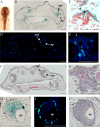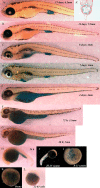Senescence gives insights into the morphogenetic evolution of anamniotes
- PMID: 28500032
- PMCID: PMC5483031
- DOI: 10.1242/bio.025809
Senescence gives insights into the morphogenetic evolution of anamniotes
Abstract
Senescence represents a mechanism to avoid undesired cell proliferation that plays a role in tumor suppression, wound healing and embryonic development. In order to gain insight on the evolution of senescence, we looked at its presence in developing axolotls (urodele amphibians) and in zebrafish (teleost fish), which are both anamniotes. Our data indicate that cellular senescence is present in various developing structures in axolotls (pronephros, olfactory epithelium of nerve fascicles, lateral organs, gums) and in zebrafish (epithelium of the yolk sac and in the lower part of the gut). Senescence was particularly associated with transient structures (pronephros in axolotls and yolk sac in zebrafish) suggesting that it may play a role in the elimination of these tissues. Our data supports the notion that cellular senescence evolved early in vertebrate evolution to influence embryonic development.
Keywords: Axolotl; Evolution; Morphogenesis; Pronephros; Senescence; Zebrafish.
© 2017. Published by The Company of Biologists Ltd.
Conflict of interest statement
Competing interestsThe authors declare no competing or financial interests.
Figures




References
-
- Coppé J.-P., Patil C. K., Rodier F., Sun Y., Muñoz D. P., Goldstein J., Nelson P. S., Desprez P. Y. and Campisi J. (2008). Senescence-associated secretory phenotypes reveal cell-nonautonomous functions of oncogenic RAS and the p53 tumor suppressor. PLoS Biol. 6, 2853-2868. 10.1371/journal.pbio.0060301 - DOI - PMC - PubMed
-
- Deschenes-Simard X., Gaumont-Leclerc M.-F., Bourdeau V., Lessard F., Moiseeva O., Forest V., Igelmann S., Mallette F. A., Saba-El-Leil M. K., Meloche S. et al. (2013). Tumor suppressor activity of the ERK/MAPK pathway by promoting selective protein degradation. Genes Dev. 27, 900-915. 10.1101/gad.203984.112 - DOI - PMC - PubMed
LinkOut - more resources
Full Text Sources
Other Literature Sources

